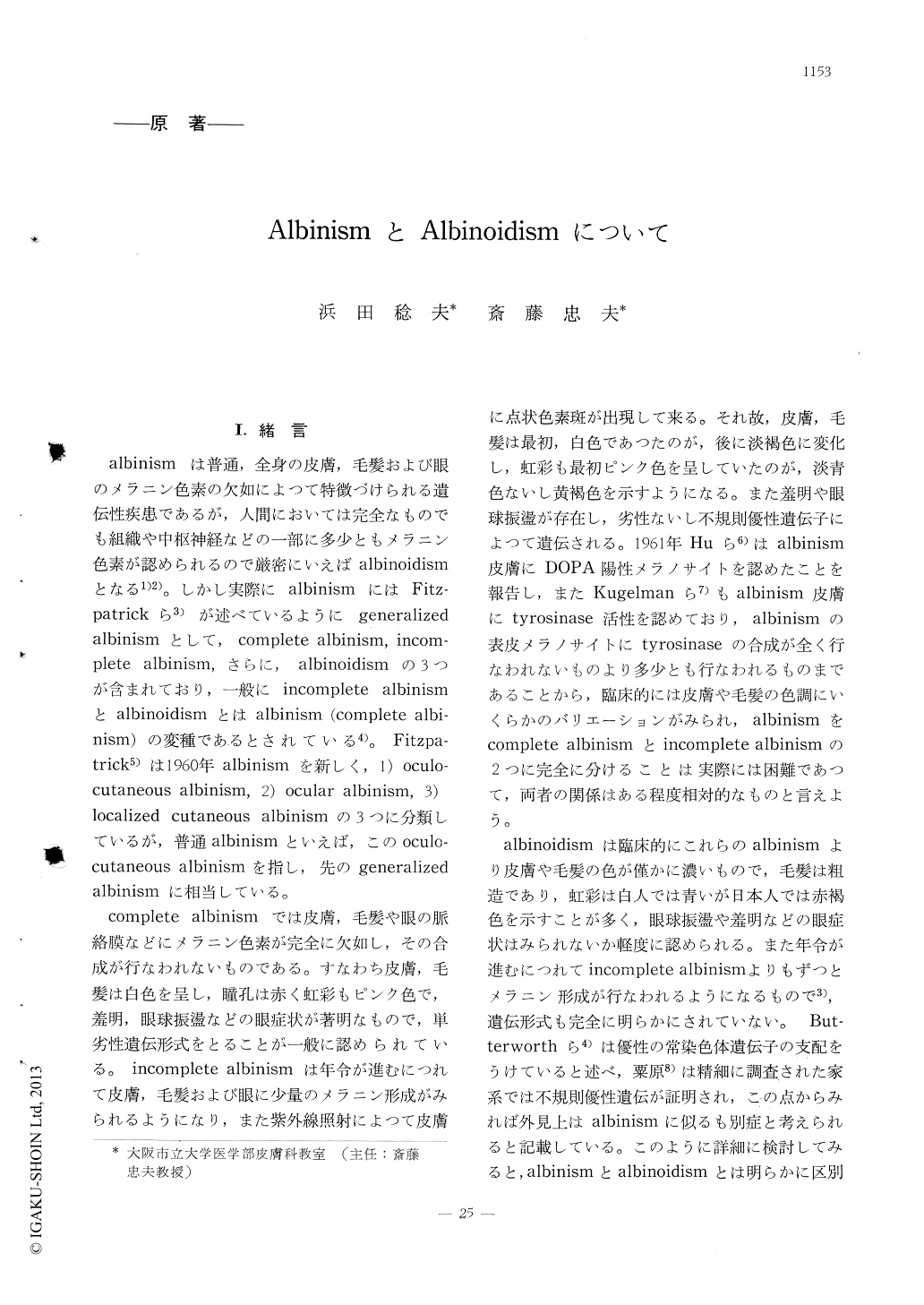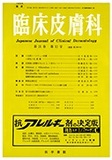Japanese
English
- 有料閲覧
- Abstract 文献概要
- 1ページ目 Look Inside
I.緒言
albinismは普通,全身の皮膚,毛髪および眼のメラニン色素の欠如によつて特徴づけられる遺伝性疾患であるが,人間においては完全なものでも組織や中枢神経などの一部に多少ともメラニン色素が認められるので厳密にいえばalbinoidismとなる1)2)。しかし実際にalbinismにはFitz-patrickら3)が述べているようにgeneralizedalbinismとして,complete albinism, incom-plete albinism,さらに,albinoidismの3つが含まれており,一般にincomplete albinismとalbinoidismとはalbinism (complete albi-nism)の変種であるとされている4)。Fitzpa-trick5)は1960年albinismを新しく,1) oculo-cutaneous albinism,2) ocular albinism,3)localized cutaneous albinismの3つに分類しているが,普通albinismといえば,このoculo-cutaneous albinismを指し,先のgeneralizedalbinismに相当している。
complete albinismでは皮膚,毛髪や眼の脈絡膜などにメラニン色素が完全に欠如し,その合成が行なわれないものである。すなわち皮膚,毛髪は白色を呈し,瞳孔は赤く虹彩もピンク色で,羞明,眼球振盪などの眼症状が著明なもので,単劣性遺伝形式をとることが一般に認められている。incomplete albinismは年令が進むにつれて皮膚,毛髪および眼に少量のメラニン形成がみられるようになり,また紫外線照射によつて皮膚に点状色素斑が出現して来る。それ故,皮膚,毛髪は最初,白色であつたのが,後に淡褐色に変化し,虹彩も最初ピンク色を呈していたのが,淡青色ないし黄褐色を示すようになる。また羞明や眼球振盪が存在し,劣性ないし不規則優性遺伝子によつて遺伝される。1961年Huら6)はalbinism皮膚にDOPA陽性メラノサイトを認めたことを報告し,またKugelmanら7)もalbinism皮膚にtyrosinase活性を認めており,albinismの表皮メラノサイトにtyrosinaseの合成が全く行なわれないものより多少とも行なわれるものまであることから,臨床的には皮膚や毛髪の色調にいくらかのバリエーションがみられ,albinismをcomplete albinismとincomplete albinismの2つに完全に分けることは実際には困難であつて,両者の関係はある程度相対的なものと言えよう。
Clinical and histological studies were done in two sisters (37-and 33-year-old) with albinism and in 3 patients with albinoidism (26-year-old female 9-year-old boy and 20-year-old male), to establish differential features of the both entities.
In albinism, the color of the skin and hair were white, and no pigmentation was observed on the mamillae. The iris was reddish, and the ocular fundus was translucent, where the blood vessels were visible more clearly. A few pigmented spots of 1 to 2 mm. in diameter appeared following irradiation of the skin with the ultraviolet light. No melanin granules could be seen in the whole skin except for the pigmented spots. In the younger sister of albinism, a few dopa-positive melanocytes were found at the basal layer of the abdominal skin.
In albinoidism, on the other hand, a little more pigmentation of the skin was found over the whole body than in albinism. The color of the skin in albinoidism was not so white as in albinism, the color of hair was brown or brownish black, and that of the mamillae was faint. The ocular fundus was more translucent than the normal, and the blood vessels of choroid were visible faintly. Patterned dopa-positive melanocytes were observed at the basal layer of the epidermis. If a Japanese subject were halfblooded with a Caucasian, the discernment with albinoidism would be difficult.

Copyright © 1967, Igaku-Shoin Ltd. All rights reserved.


